Ретро мотоциклы
Блог посвящён старинным мотоциклам в стиле ретро, классика, винтажная мототехника
Администраторы (1)
Модераторы (0)
Читатели (507)
Ретро мотоциклы → Мотоцикл Krauser MKM1000 #1/237
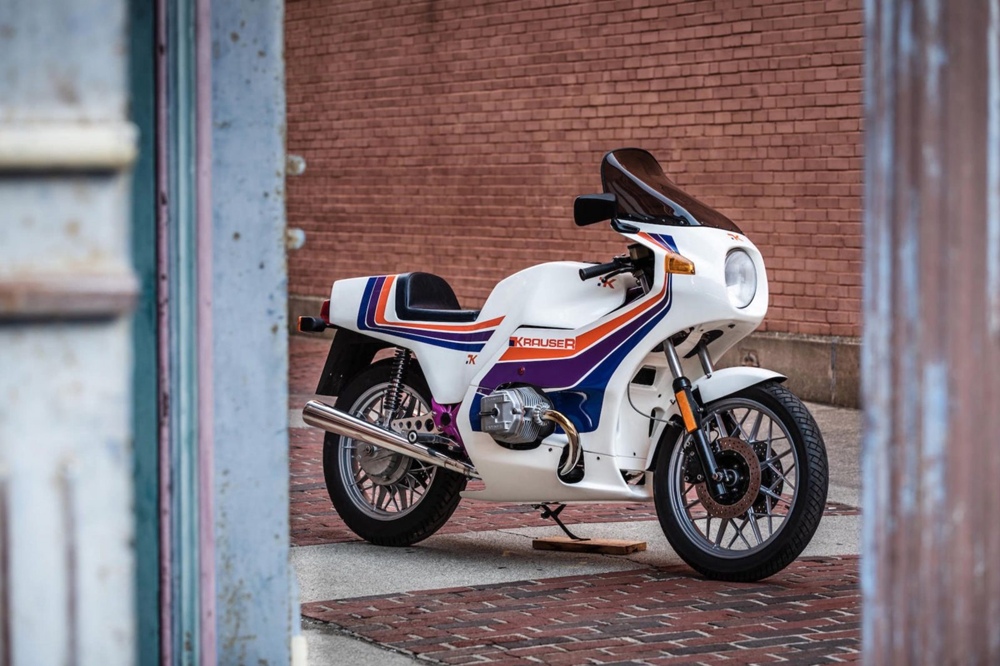
Мотоцикл Krauser MKM1000 спроектировал немецкий гонщик Михаэль Краузер (Michael Krauser), который использовал передовые компьютерные технологии для разработки рамы. Он сотрудничал с инженерной компанией HPN, основаной Альфредом Хальбфельдом (Alfred Halbfeld), Клаусом Пепперлом (Klaus Pepperl) и Михаэлем Неэром (Michael Neher).
В 1950-х годах Михаэль Краузер прославился долгой карьерой гонщика на сайдкарах BMW. Он выигрывал национальное немецкое первенство в 1955-1958 годах. Завершив карьеру, занялся управлением командой. В 1970-х годах Краузер стал известным проектировщиком и производителем багажных систем для мотоциклов.
Михаэль всегда мечтал изготовить собственный мотоцикл. У него были средства, а также хорошие отношения с BMW, поэтому использовал в качестве основы двигатель и трансмиссию BMW; электрику, тормоза, подвеску от BMW R100RS.
Рама — шедевр Краузера, который хотел развивать технологии немецких рам. В конце 1970-х годов компьютерное проектирование было относительно новым. Михаэль использовал 52 прямые хромомолибденовые трубы, 4 изогнутые. В общей сложности получилось 150 сварных мест. Рама типа «птичья клетка» весила всего 11.6 килограмм (на 6 кг меньше стоковой рамы BMW).
Кроме рамы, были сделаны другие изменения: заниженная на 40 мм вилка, изменён наклон/след вилки, новые подножки, металлический топливный бак, аэродинамический обтекатель, широкий маятник, широкое заднее колесо. Мотоцикл Krauser MKM1000 выделялся хорошим управлением и немецкой надежностью, но стоил слишком дорого — 14 000$. В 1980-1982 годах продали всего 237 мотоциклов.
В наши дни мотоциклы Krauser MKM1000 популярны среди коллекционеров. Ценник обычно колеблется между 30 000 — 50 000 долларов.
На фото представлен Krauser MKM1000, оснащенный 4-клапанным оппозитом BMW R100RS мощностью 72 л.с., 40-мм карбюраторами Dell’Orto PHM, кулачками BMW 336R, глушителями в стиле Ducati-Conti. Мотоцикл будет продан с аукциона Bonhams, который состоится 6-го октября. Ориентировочная стоимость: 35 000 — 45 000 долларов.
Motorcycle History мотоциклы
Обзор мотоцикла Suzuki V-Strom 1000 (DL 1000)
Читать
Brough Superior 11-50. Обзор + видео
Японский военный мотоцикл Rikuo Type 97. В производстве с 1937 года. Объём двигателя 1274 см³, мощность 24 л.с. Масса 500 кг, скорость до 96 км/ч

Обзор мотоцикла Suzuki DR-Z 400 (S, SM, E)
Мотоцикл Nimbus Type C Стива Маккуина
Harley-Davidson XLH Sportster 1200, 1992 г.
Тип: Чоппер / Кастом / Круизер
Двигатель и привод
Рабочий объем: 1198 см3
Тип: V2
Тактов: 4
Мощность: 49.00 л.с. (35.8 кВт)) @ 5200 об./мин.
Компрессия: 9.0:1
Диаметр х Ход поршня: 88.8 x 96.8 мм (3.5 x 3.8 дюймов)
Клапанов: 2
Диаметр х Ход поршня: 88.8 x 96.8 мм (3.5 x 3.8 дюймов)
Контроль топлива: OHV
Охлаждение: Воздушное
Коробка передач: 4 скорости
Привод: Ремень
Вместимость бензобака: 8.5 л.
Передняя покрышка: 100/90-19
Задняя покрышка: 130/90-16
Передний тормоз: Один диск
Задний тормоз: Один диск
DKW NZ500
Германия ??, 1941
Первая компания датчанина Йоргена Скафте Расмуссе была организована в 1907 году и занималась производством стационарных паровых машин, а также разнообразной паровой и водяной арматуры. Позже, из-за военного бензинового кризиса, паровые двигатели получили огромную популярность, и Йорген собрал несколько опытных образцов паровых машин, и даже зарегистрировал новую компанию DKW. Название означало «Паровой автомобиль» (Dampf Kraft Wagen).
Однако производство машин так и не наладили, зато решили серийно выпускать небольшие моторы, которые можно было установить на велосипед. В послевоенной Германии было продано более 1000 штук, а фирма получила новую расшифровку – «Мечта мальчишки» (Des Knaben Wunsch). Компания планомерно развивалась и выпускала во многом революционные двигатели, их использовали другие компании, а успешные выступления в соревнованиях только закрепляли успех.
В 1930-х были выпущены новые модели – «NZ 250» (247 см3, 9 л.с.) и «NZ 350» (246 см3, 11,5 л.с.), которые кардинально отличались от всех предыдущих мотоциклов DKW. Во-первых, переработанный двигатель получил цепную моторную передачу под алюминиевой крышкой картера. Во-вторых, коробка передач стала четырехступенчатой, а в дополнение к ручному появился и ножной механизм переключения передач. Версия «NZ 500» (489 см3, 18,5 л.с.) появилась годом позже и отличалась не только модернизированным шасси и силовым агрегатом, но и появившейся свечной задней подвеской, которую можно было регулировать по жесткости в зависимости от того, использовалась ли машина с коляской или в одиночном варианте.
Ducati Apollo 1964 года – прототип с двигателем V4
Indian Scout Bobber, 2018 г.
Мощность: 94 л. с.
Макс. скорость: 200 км/ч.
Характеристика электромотоцикл Kawasaki Z1000 SR, плюсы и минусы, цена

Производитель решил дать возможность самому выбирать необходимые технические данные покупателю, так сказать, собирать электромотоцикл Kawasaki Z1000 SR. Максимальная скорость, которая может быть у этой модели – 170 км/ч. Аккумулятор также выбирается самим покупателей, максимальный показатель достигается при акб 72 V 120 Ah, так, запас хода будет хватать до 230 000 метров. Что еще есть в Kawasaki Z1000 SR, можете прочесть ниже.
Технические характеристики

- Материал – пластик;
- Рама изготовлена из высокопрочной стали;
- Габариты – 207х76х120 см;
- Сиденье –75-85 см;
- Руль – ширина 70 см;
- Колеса – покрышка передняя 110/70-17 задняя 140/70-17, вакуумная;
- Максимальная нагрузка – 150-200 кг;
- Возможный угол наклона – 30 градусов;
- Аккумулятор – литий-ионный;
- Количество циклов заряд-разряд – 1500;
- Водонепроницаемость – есть;
- Тормоза – слева: передний, дисковой 230 мм, справа: задний, дисковой 220 мм;
- Свет – поворотники, ближний свет, светодиодный;
- Дисплей – есть, ЖК, цветной;
- Защита от угона – есть;
- Защитная рама – есть;
- Условия эксплуатации –от -10 градусов до +40 градусов.
- Амортизация – присутствует;
- Ножная педаль – алюминиевая.
Как было сказано выше, комплектацию может покупатель выбирать сам при заказе, в меру своих потребностей и бюджета.
Мощность

- При выборе мощности 2000 W бесщёточной максимальная скорость будет варьироваться от 80 до 85 km/час.
- При 3000 W скорость можно будет набрать в пределах 90-120 км/ч.
- 4000 W – 120 км/ч.
- 5000 W – 140 км/ч.
- И максимальная мощность равна 8000 W с ней можно набрать скорость движения равной 170 км/ч.
Аккумулятор

Емкость выбранного аккумулятора определяет максимальный запас хода.
Так, при выборе 72V 30 Ah проходимость будет равна до 60 000 метров.
При 72V 60 Ah до 120 км.
72V 90 Ah – до 180 км;
И самая высокая емкость равна 72V 120 Ah, так вы сможете проехать до 230 км без подзарядки.
Все аккумуляторы для электромотоцикла KawasakiZ1000 SR литий-онные , производитель гарантирует минимум 1500 циклов зарядки.
Вес варьируется от 13 до 33 килограмм.
Важно! Цена начинается с 55 000 тысяч рублей, далее 95 000, 120 000 и 150 000 тысяч рублей. Стоимость, конечно, достаточно высокая, но качество и итог стоят того.
Дизайн

Выполнен Kawasaki Z1000 SR из прочного современного пластика, но рама сделана из стали.
Каждая деталь продумана, она полностью вписывается в стиль мотоцикла, выглядит богато. С цветами конструкции стоит ознакомиться у заказчика.
Создана защитная рама, которая защитит вашего зверя от царапин, не давая испортить внешний вид Kawasaki Z1000SR.
Преимущества
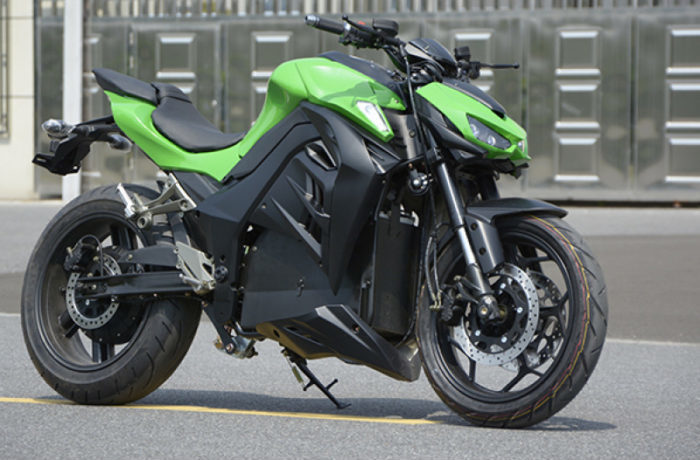
- Экологичный. Благодаря тому, что мотоцикл работает от энергии, никакие выхлопные газы не вырабатываются;
- Возможный выбор нужной комплектации;
- Экономия. Теперь не нужно каждый раз тратить свои сбережения на бензин, стоит потратить однажды крупную сумму и только;
- Стильный;
- Большее КПД, которое выше бензинного;
- Бесшумный.
Рекомендуем:
- Электромотоцикл Kawasaki: обзор, его характеристики, возможности и стоимость
- CS-EBIKE-P1: отзывы, особенности и цена электрического байка
- Электромотоцикл Soco: обзор на электромотоцикл, характеристика и стоимость
Недостатки

- Необходимо около 8-10 часов, чтобы зарядить аккумулятор, также, грубо говоря, зависимость от розетки;
- Нет технического обслуживания, в случае поломки, не факт, что Вам смогут помочь в сервисном центре;
- Данная покупка не бюджетная, стоит он крупную сумму, которую не все готовы и могут отдать.
Подведем итог

Электромотоцикл Kawasaki Z1000SR – мощный, оснащенный, мотоцикл с большими возможностями на дороге, стильный, приковывающий взгляды. Выбирать комплектацию можете сами, нужную для Вас. Это очень удобно, производителю за это большой плюс. В целом, хорошая модель, из электрических мотоциклов один из самых мощных.
Купить
Видео: Kawasaki Z1000 — Плюсы и Минусы — 140 сил подешману
A Krauser MKM 1000 4-Valve – 1 of 237 Ever Made
Reading time: about 3 minutes.
The Krauser MKM 1000 is a German motorcycle developed by motorcycle racer Michael Krauser using a state-of-the-art computer-designed space frame developed in partnership with an engineering company named HPN – named for the first initial of each of the founder’s surnames Alfred Halbfeld, Klaus Pepperl, and Michael Neher.
Michael Krauser and the Krauser MKM 1000
Michael Krauser enjoyed a long and illustrious career as a works BMW sidecar motorcycle racer in the 1950s, winning the national German championships in 1955, 1956, and 1957, and 1958. Krauser moved from riding to race team management, and by the 1970s he had expanded into the field that he would be most famous for – designing and manufacturing motorcycle luggage.
The one dream Krauser had always cherished was the dream of building his own motorcycle, and by the late 1970s he had the required capital combined with decades of connections with BMW. For obvious reasons he chose to use BMW engines and drivetrains, as well as suspension, brakes, and electrics – specifically from the BMW R100RS.
The real magic of the Krauser MKM 1000 would be its frame. In such the same way that specialist companies like Seeley and Rickman in Britain had been developing lightweight racing frames, Krauser wanted to develop a suitably advanced German frame for the iconic BMW boxer engine.
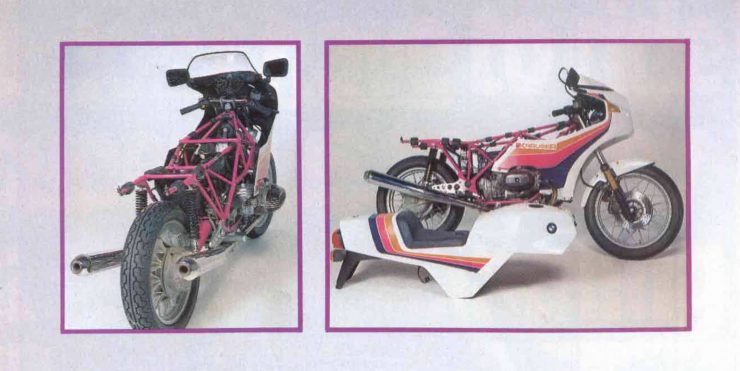
The use of computers in frame design was still relatively new in the late 1970s, though after much experimentation a new space frame was developed that used 52 straight and 4 slightly bent chromium-molybdenum steel tubes requiring welds at 150 points.
This new frame, nicknamed the bird cage by period motorcycle journalists, weighed in at just 11.6 kilograms – 6 kilograms less than the original BMW frame. A series of other changes were made when integrating the BMW parts, the engine sat slightly higher, the front forks were an inch and a half lower, rake and trail were increased, custom rear sets were developed as well as a metal fuel tank that is hidden under the elegant one piece tank cover, seat, rear cowling. A matching aerodynamic fairing was developed for use on the autobahns, and a wider swingarm allowed the fitment of a wider rear wheel with subsequently wider rear rubber.
Though the Krauser MKM 1000 was a beautifully designed motorcycle with excellent handling and characteristic German reliability, it was astonishingly expensive for the time at $14,000 USD apiece. This limited the sales somewhat, with approximately 237 being built between 1980 and 1982.
Today the surviving examples are wildly popular with collectors due to their excellent riding manners and extreme rarity, when they do rarely come up for sale they typically change hands for anything from $30,000 to $50,000+ USD depending on condition.
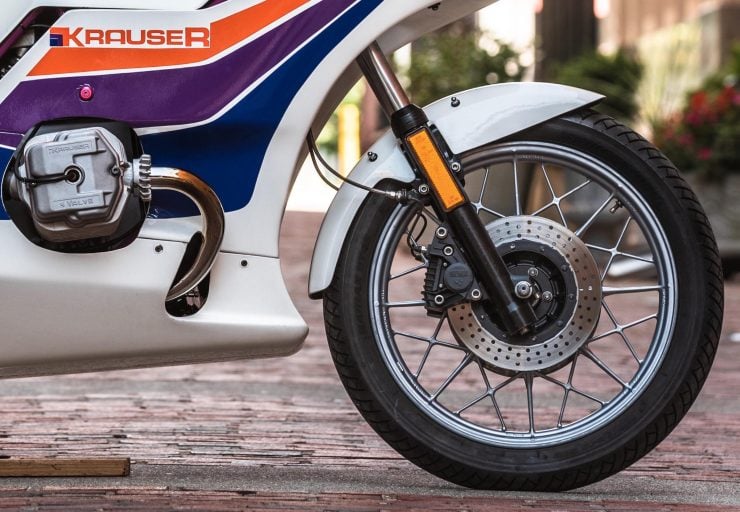
The 1983 Krauser MKM 1000 4-Valve
The motorcycle you see here is the single best equipped Krauser MKM 1000 we’ve ever come across. It’s fitted with the rare Krauser 4-valve heads bumping power from 60 hp to 72 hp, as well as a pair of 40mm Dell’Orto PHM carburetors, a BMW 336Rs sport cam, and Ducati-Conti-style stainless steel mufflers.
Though there’s no dyno chart available it’s safe to say that this is a bike now producing notably over the 72 hp you’d expect from a BMW R100RS twin with 4-valve heads. The current owner has had the bike for over 20 years, maintaining it in excellent condition.
The bike is due to roll across the auction block with Bonhams on the 6th of October with an estimated value of between $35,000 and $45,000 USD, representing a rare opportunity to buy what might be the best spec example of the Krauser MKM 1000 in the world. If you’d like to read more about it or register to bid you can click here to visit the listing on Bonhams.
BMW Krauser MKM 1000
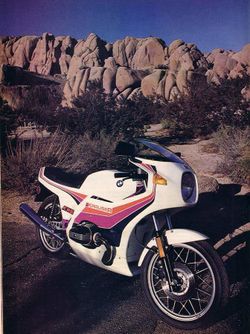 |
|
| BMW Krauser MKM 1000 | |
| Manufacturer | |
|---|---|
| Production | 1981 |
| Class | Sport Bike |
| Engine | |
| Bore / Stroke | 94.0mm x 94.0mm |
| Compression ratio | 8.2:1 |
| Horsepower | 70.0 HP (52.2 KW) @ 7500RPM |
| Torque | 56.06 ft/lbs (76.0 Nm) @ 5500RPM |
| Transmission | Gear box: Gear
Final Drive: Chain Clutch: Wet multi plate |
| Suspension | Front: 36mm BMW modified forks Rear: Boge dual shocks |
| Brakes | Front: dual 259mm discs Rear: single disc |
| Front Tire | 3.50xV19 |
| Rear Tire | 130/80xV18 |
| Wheelbase | 59.41 inches (1509 mm) |
| Weight | 212.0 kg (wet) |
| Manuals | Service Manual |
The BMW Krauser MKM 1000 was a air-cooled, four-stroke, boxer twin cylinder, 4 valves per cylinder Sport Bike motorcycle produced by BMW in 1981. Max torque was 56.06 ft/lbs (76.0 Nm) @ 5500 RPM. Claimed horsepower was 70.0 HP (52.2 KW) @ 7500 RPM.
Contents
Engine [ edit ]
A 94.0mm bore x 94.0mm stroke result in a displacement of just 980.0 cubic centimeters.
Drive [ edit ]
The bike has a Gear transmission. Power was moderated via the Wet multi plate.
Chassis [ edit ]
It came with a 3.50xV19 front tire and a 130/80xV18 rear tire. Stopping was achieved via dual 259mm discs in the front and a single disc in the rear. The front suspension was a 36mm BMW modified forks while the rear was equipped with a Boge dual shocks. The wheelbase was 59.41 inches (1509 mm) long.
1981 BMW Krauser MKM 1000 [ edit ]
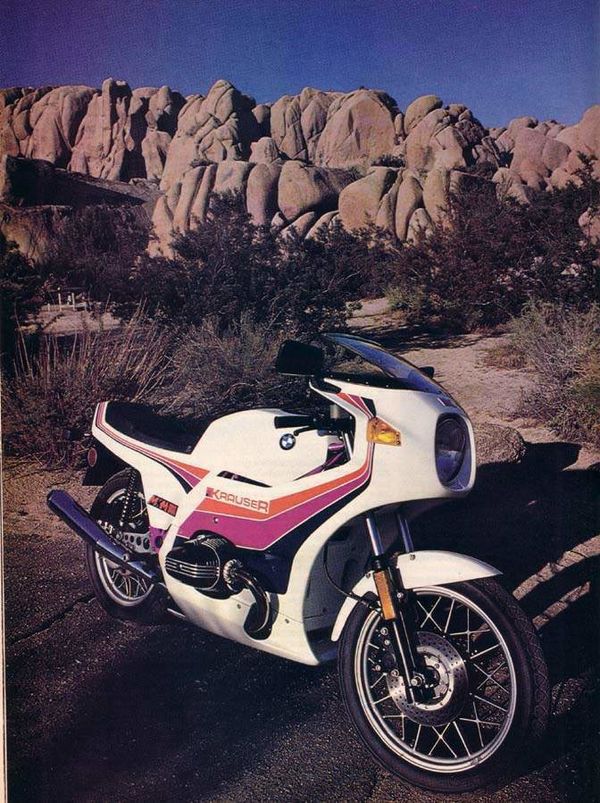
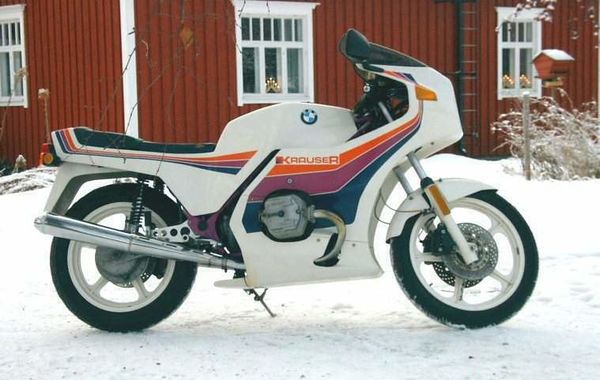
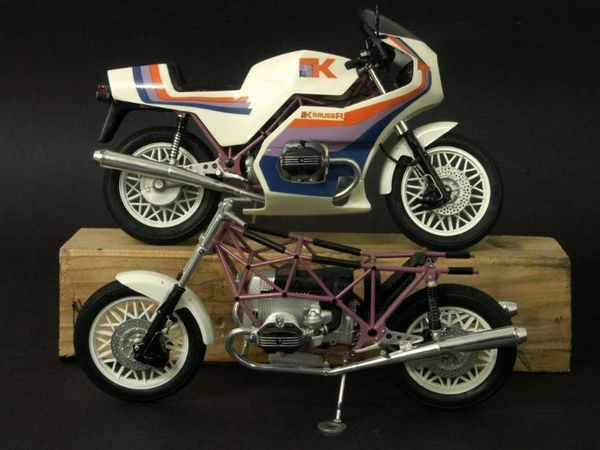
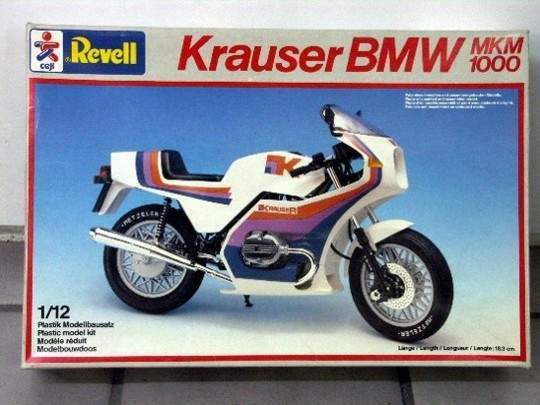
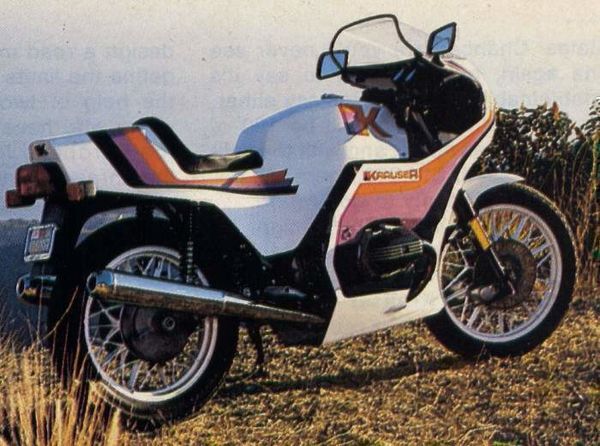
The 1981 MY BMW MKM 100 has, at its heart, an air-cooled, four-stroke, 980cc, boxer twin cylinder powerplant paired to a five-speed manual transmission that can produce a claimed 70 horsepower and 75 Nm of torque. It comes with features such as a 36mm telescopic fork, Boge dual shocks as a rear suspension, laced wheels, dual front disc brakes, a small windscreen, a full fairing, a large headlamp, a dual seat and an analogue instrument cluster.
Мотоцикл Krauser MKM1000 (1980): технические характеристики, фото, видео
BMW Krauser MKM 1000
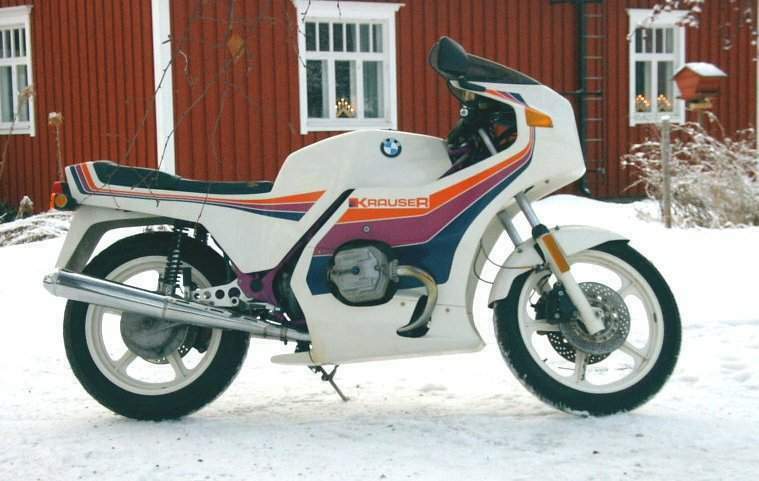
Make Model
Year
Engine
Four stroke, two cylinder horizontally opposed Boxer, pushrod operated 4 valves per cylinder.
Capacity
Induction
Ignition
Max Power
Max Torque
Transmission
Front Suspension
Front Wheel Travel
Rear Suspension
Rear Wheel Travel
Front Brakes
Rear Brakes
Front Tyre
Rear Tyre
Dry Weight
Fuel Capacity
Consumption Average
Standing ј Mile
Top Speed
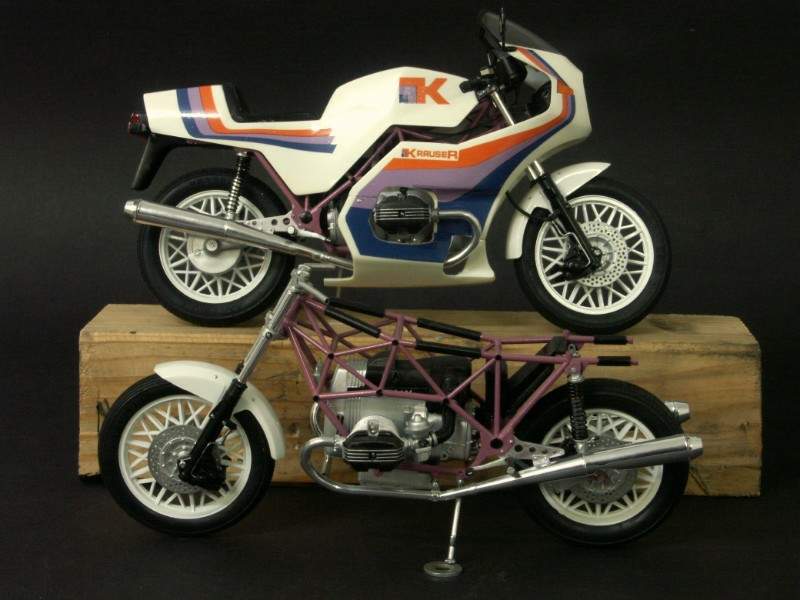
There will always be a small number of motorcycle enthusiasts who insist on something different; it is their aim to improve upon excellence. If the prime mover is a German, he will usually pick on his native BMW as a candidate for the treatment. So it was with Mike Krauser, his name already famous for high quality, quickly detachable luggage systems. He looked at the top BMW of the time, the sporting R100RS, and found it wanting.
First thing to go was the frame. Comfortable suspension and plenty of room for two had no place on the super-sporting machine he envisaged; nor did the simple (and inevitably flexible) tubular frame. Krauser commissioned German aircraft engineers to design an alternative, and they came up with a masterpiece of complexity, a veritable bird-cage of short, straight tubes that double- and triple-triangulated one another for maximum rigidity, The BMW suspension was modified to eliminate the mid-corner wallows, then the whole was clothed in compact bodywork that echoed the BMW’s austere styling without the bulk; the petrol tank, seat and rear mudguard were unified in one piece of glass fibre. Krauser then turned to the flat-twin engine. The overall design was excellent, well-balanced and well-cooled, but he wanted more flexibility as well as more urge at high revs. He commissioned a more modern four-valve head to replace the BMW’s two valves, which not only improved the breathing throughout the rev range, but also lifted the rev ceiling.
The MKM1000 was a long time in the making, and all the careful development work has produced a fine bike. To ride, it is essentially a BMW – the familiar Boxer engine and the sensations of the shaft drive see to that. But it is a BMW apart. First, there is the riding position, crouched over the bars in a sporting style. It throws the weight forward rather uncomfortably at lower speeds, but the more the wind lifts the rider, the better control becomes.
The handling is concomitantly sporting, with a far more direct response to the subtleties of control than any standard BMW. Engine modifications perform the same function of tautening up the German luxury bike to release its sporting potential. Curiously, the first sensation of the four-valve engine is of milder manners, since the Krauser pulls smoothly and strongly from below 3,000rpm. It is the crispness higher up Ihe rev range that makes it a 130mph-plus machine. The MKM1000 is exotic, very expensive, and very rare – a special version of a rather special breed.
Source The worlds fastest motorcycles by John Cutts & Michael Scott
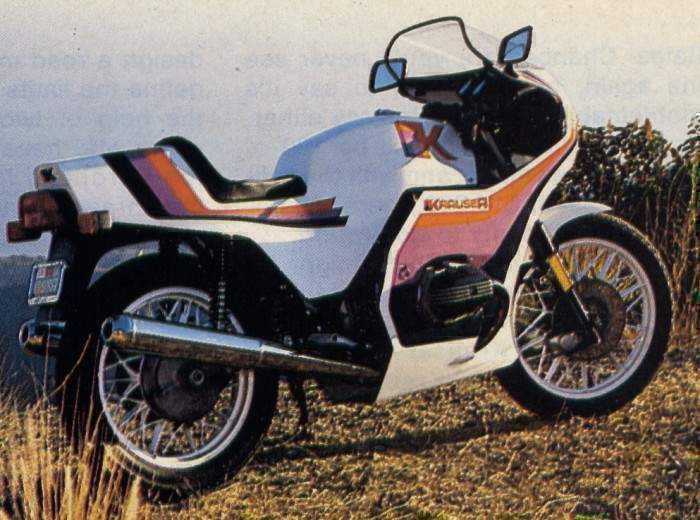
Cycle Guide Review
In Germany, motorcycles are meant to be ridden at top speed. You have no choice. The country is laced with high-speed thoroughfares called autobahns that are far twistier than American turnpikes. The speed limit is not 55 mph. The left-hand lane is restricted to highspeed cruising. Unless you keep a reasonable pace, you’re apt to be squashed like a cockroach by Porsche 928s, BMW 645s or Mercedes-Benz 450SLCs hurtling along at 200 kph.
It is the leather-suited weekend motorcyclist who craves this sort of riding who will most appreciate the Krauser MKM1000. Once you tuck behind the Whirlpool-white fairing at 90 mph, the only evidence of the hole the bike punches in the wind is a slight rustle around your ears. With your arms stretched to meet the narrow handlebar, your feet resting on hand-fabricated rearsets and your backside braced against the tailpiece, the MKM carves single-mindedly through high-speed sweepers like a racer, the BMW S-type engine throbbling like an oversize metronome. The Krauser MKM1000 is one of the best bikes for flat-out running ever built.
Motorcycle luggage and accessory manufacturer Mike Krauser had such Sunday adventures in mind when he commissioned the MKM1000 (Mike Krauser Motorcycle) for production. Krauser has sponsored racing sidecars in the past, provided some backing for Freddie Spencer’s European adventures this year and bankrolled Toni Mang’s successful pursuit of the 1980 250cc roadracing world championship, but he has long sought to stamp street riding with his own personal imprint. With this BMW-powered special, Krauser hopes to embody his vision of what a true high-performance road bike should be.
The MKM has its genesis in a development firm called HPN, composed of former endurance racer Alfred Halbfeld, a silent partner named Pepper1 and Michael Neher. In April 1979, the firm began development of a BMW-powered special because, as Neher comments, only BMW owners can afford such bikes. Furthermore, HPN elected to certify the bike as a production motorcycle with the TUV, the hard-nose German counterpart of the DOT and EPA. After $22,000 of certification and a further $115,000 of development, HPN convinced Krauser to fund a 200-unit production run.
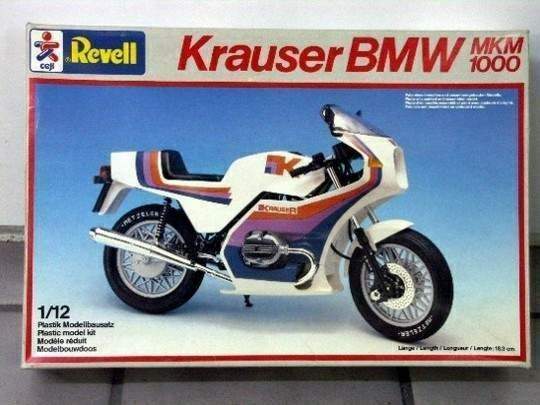
Virtually all of the MKM’s running gear comes from BMW parts bins—a move to satisfy the TUV—which insures that the MKM is a high-performance street bike instead of a streetable racer like the Bimota, Motoplast or Behn specials. The S-type BMW engine with its hot cam, 8.2:1 compression ratio and 40mm Bing CV carbs is fitted, and the wheels, exhaust pipes, brakes and shaft drive also come from the 1980 R100S (now called the R100CS). The S-model’s suspension pieces have been modified to provide less travel for greater high-speed stability, however. Stiffer preload springs do the job in front while stiff springs and heavier 10-weight shock oil do the job in the rear. This production-based hardware attests to the MKM’s expected durability and also explains why the bike qualifies as a street-legal bike in the U.S.
The linchpin of the Krauser-bike, though, is its frame. As with many of the specialty bikes these days, the frame has its roots in pre-Honda RCB endurance racing, when engine technology was closely controlled and speed had to come from chassis engineering. The MKM uses a space frame, a design offering plenty of that elusive but valuable quantity, torsional rigidity, for good high-speed handling while minimizing weight. HPN also used computer modeling to develop a space frame that uses many short lengths of small-diameter tubing. This Gitterrohrfarhwerk or birdcage-like design permits an extremely lightweight structure-25.3 pounds—that still offers substantial torsional rigidity.
Surrounding the MKM’s frame is a fiberglass body drawn by Franz Wiedemann, who learned his trade designing BMW’s R100RS and R100RT fairings in the Pininfarina windtunnel. The fairing and the one-piece tank/seat/tailpiece attach to the frame with Dzus-type fasteners. The 5.6-gallon aluminum fuel tank (with a miniscule reserve capacity) lies beneath the fiberglass, nestled among the frame tubes. The simple slab of foam that forms the seat can be removed to reveal a storage area in the tailpiece. A different body with a passenger seat also can be ordered for the MKM if you prefer.
Once you fit yourself into the monoposto riding position and get underway, the feedback the MKM gives you is pure BMW. Yet the Krauser bike manages to refine these sensations, reducing the amplitude of engine vibrations and controlling the rise and fall of the rear end. As a result, the MKM operates with greater precision than any BMW, including the way the rearset shift lever snaps through clunk-free gearchanges.
As the open road beckons, the MKM chassis goes to work like no other BMW as well. Not a trace of high-speed BMW-weave can be detected. A wheelbase one-inch longer than the R100S’s provides part of the reason. Also, the engine has been raised 25mm in the frame for greater ground clearance, which gives the MKM a higher center of gravity for even more straightline stability.
For all its autobahn-calibrated manners, the Krauser bike adapts to scratching in the corners fairly well. The steering in particular is incredibly precise. The narrow handlebar and high cg prevent you from pitching the bike into corners with abandon, but the MKM’s steadiness under all circumstances proves to be a great go-fast asset. The engine complements your roadracing fantasies because the great, fund of torque on hand allows you to concentrate on riding instead of shifting. Meanwhile, the oversize Metzeler tires also are up to the roadholding capabilities of the chassis (the swingarm has been widened to permit the installation of the 130/80V18 rear tire).
Still, there’s rarely any question about how bikes like the MKM1000 react to speed. It’s everyday use that separates the winners from the losers. Because of the use of BMW components, the Krauser bike actually is easier to live with than most one-off machines. Even so, the MKM stumbles when it comes to comfort. Unless you’re cruising at more than 80 mph, there’s not enough wind pressure to help you sustain the riding position, so the narrow R100RS handlebar soon introduces you to wrist wreck. Also, the suspension is simply oversprung. It will pound your joints to powder on any trip over city streets or Interstate. The Europeans unfortunately equate a rocky ride with high performance, thinking that the thumps signal a tautly strung bike that fosters a closer relationship of man and machine. And this classic confusion of stiffness with streetwise road holding will wear you down after an hour of riding.
Despite its comfort limitations, the MKM1000 is indeed the ultimate BMW it set out to be. It’s the sort of motorcycle you’d trailer behind your Audi 5000 Turbo to some Alpine locale for an afternoon run.
It’s difficult to know if the MKM design will prove as significant in the long run as Mike Krauser hopes, however. The space frame does indeed combine stiffness with low weight. Also, the MKM frame actually affords access to the engine, allowing you to pull the top end without removing the engine from the frame—although this feature is largely a function of the engine design rather than the frame. Still, this point could be moot, for engine durability these days is such that removing the engine from the frame is an accepted part of major maintenance—as with the Honda CB750. But the spaceframe’s advantages are all but cancelled by one thing—price. The MKM1000 will cost, $15,000 at various BMW dealers in this country, largely because of the labor cost of building its frame. And for this reason, the Krauserbike will remain one of the world’s best limited production BMWs—but probably not the next full-scale production BMW.—Michael Jordan ■
The Holy Grail of BMWs: Krauser MKM1000










1982 Krauser MKM1000
Claimed power: 70hp @ 7,500 rpm
Top speed: 140 mph
Engine: 980cc air-cooled OHV flat twin, 94mm x 70.6mm bore and stroke
Weight (wet): 496lb (225kg)
Fuel capacity/MPG: 5.5gal (21ltr)
Price then/now: $11,985/$15,000-$25,000
Here’s a riddle: When is a BMW not really a BMW? When it’s a Krauser MKM1000, of course.
We’ll get to the motorcycle in a moment, but first, some history about Mike Krauser Motorcycle, or MKM as it is better known. German-born Michael Krauser is famous for his motorcycling achievements. In the 1950s, Krauser competed aboard works BMW machines, winning the German sidecar racing championship from 1955 to 1958. In the 1960s he ran a team of Rennsport outfits. In the 1970s Krauser not only introduced a successful line of motorcycle luggage, he also managed BMW factory sidecar racing teams. And then, in the latter part of the decade, he decided to build complete motorcycles.
Krauser’s is a deep and rich history — and the company is still in business today. According to their website, Krauser began in 1924 repairing engines and manufacturing pistons. In 1963, Krauser took over a BMW dealership, selling cars, and providing parts and service. With his background in motorcycles, in 1970 Krauser added two-wheelers to the range.
Tired of modifying luggage to fit motorcycles, in 1972 Krauser developed his first removable, injection-molded plastic side cases. His line of luggage became synonymous with BMW, but the company developed a product range to fit numerous other brands. According to one source, Krauser had 70 employees working to meet demand for the product.
But this success didn’t satisfy Krauser. By all accounts, he was a “motorcyclist’s motorcyclist,” someone who longed to be involved in something much grander in scale. That just happened to be the production of a street legal motorcycle.
Beginnings of the MKM1000
In the mid-1970s, Krauser had designed a race motorcycle featuring a 1,000cc BMW boxer engine surrounded by a much stiffer frame than what would have been stock. The machine was competitive, and the lessons learned, Krauser felt, were too important to simply leave at the track. However, when it came time to design a road-going machine, Krauser didn’t rely solely upon his own experiences. He instead worked with HPN — a development firm with three young engineers including Alfred Halbfeld, Klaus Pepperl and Michael Neher.
“He was in tight with BMW,” says BMW restorer and collector Phil Rose of Mike Krauser. “He had been involved with endurance racing and had always wanted to build his own motorcycle. In the late 1970s, the easiest path for him to do this was to use BMW mechanicals, and BMW got on board and supplied him with components.”
BMW provided all mechanical parts, including stock BMW R100RS engines, transmissions and final drives. Forks, handlebars, switchgear and brakes are BMW. Even the exhaust and mufflers are BMW, but mounted in such a way that they sweep up more sharply than they do on the R100RS.
And here we come back to our earlier riddle. In Germany, the MKM was certified as a production motorcycle. Although so much of the MKM is quite obviously BMW, instead of BMW serial numbers on drive components, for example, all parts are stamped with a “K” and then a Krauser number. As long as the drivetrain components were stock, BMW warrantied them.
The heart of the matter
Yet it’s not really about the running gear, anyway, because it’s the computer-designed space frame that sets the MKM apart. Constructed of regular thin-wall steel tubes, of which there are 52 straight tubes and four curved tubes welded together at 150 points, the entire frame weighs 25.3 pounds. In the early 1980s all of those frame tubes led contemporary bike magazines to dub the chassis “birdcage-like.” Painted magenta (purple) on some bikes (one period reviewer referred to it as “puke purple”), the frame is really what makes the Krauser special.
The fairing, seat cowl and tank cover are fiberglass, while the gas tank is metal. The tank cover and seat cowl are one piece, with the gas tank hiding underneath. The seat pan is held in place with a lock, and a post at the front and two screws at the rear are all that hold the one-piece bodywork to the frame. Dzus-type fasteners secure the lower fairing sections, while the upper fairing is bolted to the frame via a stock R100RS bracket and two other mounting points.
When compared to a stock BMW R100RS, in the MKM frame the 980cc flat twin air-cooled engine was raised by 1 inch. The wheelbase was longer, too, by 1.7 inches. The fork, however, featured shorter stanchions with travel decreased by 1.575 inches. Rake and trail were increased and Krauser designed the special rearsets and foot controls. The distinctive paint was a reflection of Krauser’s racing colors.
To be classified as a production motorcycle Krauser had to obtain German TUV certification, something that wasn’t simple to do. Similar to the DOT, the TUV puts a machine through rigorous testing procedures, and if any single component fails it’s back to the drawing board. A good reason to use proven BMW components.
Production begins
MKM production began in 1980 and ended in 1982, and there are differences between the years. For simplicity, we’ll call the early bikes Generation One and the later machines Generation Two. The Gen One bikes were equipped with ATE single-piston brakes, an aluminum gas tank with a Monza-style filler, a black frame, steel cylinders and a breaker point ignition. The Gen Two machines had a steel gas tank with a stock BMW locking gas cap and were updated with Brembo dual-piston calipers, Nikasil cylinder liners and electronic ignition.
The actual number of MKM1000 motorcycles built varies widely by the source being quoted, but 200 seems to be accurate. “I don’t have a definitive source for this information, but I’d guess there might have been three or four Gen One MKM1000s sold in the U.S.,” Phil says. “They were brought in by San Jose BMW, and they cost $14,000.”
According to Phil, of the entire MKM Generation Two production during the 1982 model year, only 13 were officially sold in the U.S. by BMW North America, and these machines were again sold through San Jose BMW and imported by Krauser USA in Seattle. The Gen Two MKM1000 was slightly less expensive at $12,000, but that was still nearly double the price of a stock BMW R100RS.
“You had to be well-heeled to buy one,” Phil says. And who could be in a better financial situation than Malcolm Forbes, the millionaire publisher of Forbes Magazine? Known for his extravagant tastes in airplanes, art, automobiles and motorcycles, Forbes purchased one of the 13 “Gen Two” MKM1000s — our feature bike — and shipped it to his castle in Morocco, where he put 3,800 miles on the clock. At the time, Forbes was famously friendly with film star Elizabeth Taylor. Who knows, perhaps Elizabeth Taylor’s derriere spent some time on the back of the bi-posto, or two-up, saddle?
Acquiring an MKM — or two
Phil Rose has been motorcycling for some 35 years, starting out aboard a 1974 Honda CB550. He moved on to a Kawasaki GPz750, and then discovered BMWs.
At this point, Phil began working with mechanic Darrell Messerle and they began restoring vintage /2 BMWs. These days, instead of restoring motorcycles Phil tries to buy bikes in good original condition. Currently, he has 26 or 27 machines in his Massachusetts-based collection.
Phil wound up with the ex-Malcolm Forbes MKM1000 in a roundabout way. Nine years ago, Phil looked at three MKM1000s owned by a Long Island collector, but at the time couldn’t afford to buy one of them, let alone all three. Then, in 2011, when a deal fell through on another MKM he was pursuing in Canada, Phil discovered the Long Island MKMs were still for sale.
“I had a lot of cash because I’d sold two bikes to fund the purchase (of the Canadian bike), but he sold that one to someone else,” Phil says.
“On the collector’s website, there was still a picture of an MKM1000. I sent him a note asking if the bike was for sale, and I got a call the next morning at 8:45. I made a deal to go and look, and I took my money and my van.”
It came to pass that this time Phil bought not only one, but all three MKMs — one of which was the Forbes machine. “I was told the collector had bought the MKM from Forbes’ son, and I had the title and Malcolm Forbes’ keychain. There are a lot of high-end bikes that have his name attached to them.” In this case, however, Phil has a New Jersey Certificate of Ownership proving Forbes’ ownership of the bike.
As purchased, the Forbes MKM1000 (no. 061) required a minimal amount of work to return it to roadworthy condition. Phil freed up the brakes, rebuilding the master cylinders and calipers using factory replacement parts, which, he points out, are all still available from any BMW retailer. He dropped the oil pan, cleaned it out, changed the oil filter, added fresh oil and changed all the drivetrain fluids. The 40mm Bing carburetors were stripped and serviced.
Because the machine had such low miles, no bearings needed replacement, and even the Metzeler tires are original to the 18-inch rear and 19-inch front wheels.
Yet while the bike was mechanically sound, cosmetically it needed some TLC. “Of the three MKMs, the Forbes bike was in the worst shape,” Phil says. “He just didn’t seem to care about the bike.”
For example, when a radar detector had been mounted to the fairing, two holes were drilled to bolt it in. “I cleaned it up, filled the holes, and touched up the paint and the decals. It looked 1,000 times better when I was done with it.”
The front footpeg rubbers, which are actually cut-down left-hand Magura handgrips, were the only rubber bits Phil replaced. Phil got the bike back into proper shape, and after adding a couple hundred miles to the odometer he sold the Forbes MKM to the founder of John’s Beemer Garage.
Phil still has the other two MKM1000s in his collection, however, including a 4-valve equipped example.
“It’s typical 1980s BMW,” Phil says of riding the MKM. “On a racetrack it might be different, but on the street it’s like riding an R100RS. But you do notice a difference because you’re in a riding position that cants you more forward, and you definitely feel the change in rake and trail. The Krauser frame is what really grants you exclusivity, and because of it the MKM has become one of the holy grails of BMW collectors.” MC




